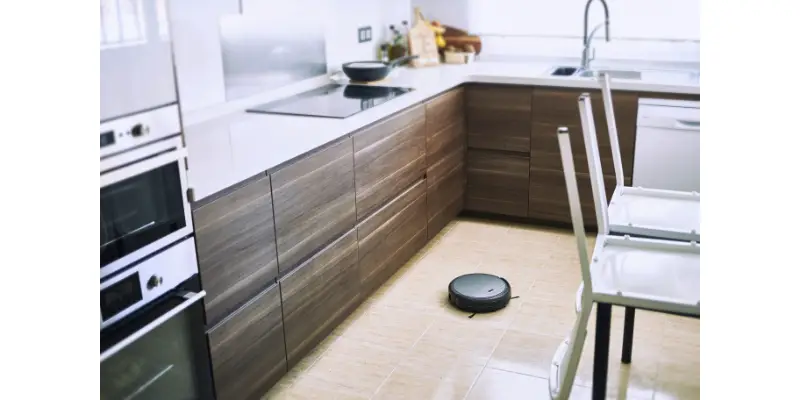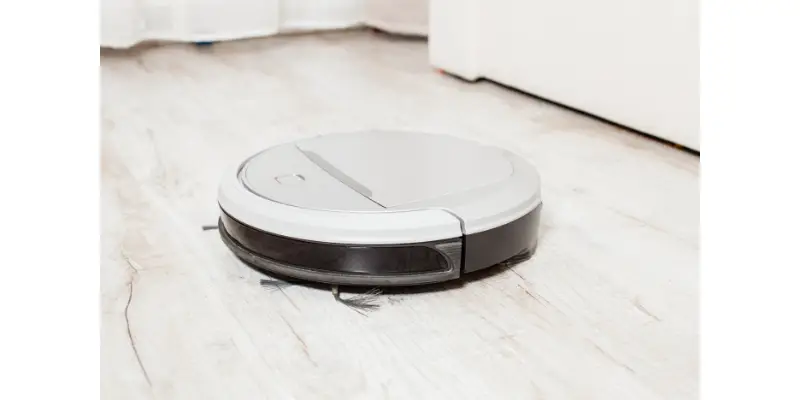Disclaimer: This post may contain affiliate links, meaning we get a small commission if you make a purchase through our links, at no cost to you. For more information, please visit our Disclaimer Page.
When a Roomba is cleaning a room, it’s constantly scanning the room to figure out the layout of the room and to detect dirt and debris.roor
Roomba comes with in-built sensors that tell it when to stop. The mechanisms will show it to either permanently or temporarily end the cleaning session. If its battery dies, it will stop temporarily; recharge it and resume cleaning.

Table of Contents
Does Roomba Learn Over Time?
The ability of Roomba to clean my whole house on its own still leaves me in awe, and it’s the main reason why it keeps gaining attention from people. This machine can effortlessly do all the chores in your house anytime you need it to do them. However, just like me, you may still wonder how it can do all this, does it learn over time.
One thing you should know about Roomba is that it can make layouts of your home. For this reason, it can clean all the rooms of your house, and sometimes it will do the cleaning following a specific room plan. To do this, it will have a map for your space.
The new Roomba can map the room, enabling them to have a smooth cleaning session. Such vacuums are therefore able to move from one room to the other and clean. However, the older versions may not be able to do the mapping of your space.
Usually, the new Roomba vacuums can gradually learn your room, and there are various ways they use to understand your room. This ability to map one’s room is due to their high accuracy in the mapping features. So, once they map your space, they will know where to start and automatically stop once they are done with the cleaning.
For Roomba to thoroughly learn your home, it can take 3 to 5 cleaning missions. During the process, they will generate an intelligent map for your home that it uses when cleaning. It tends to remember the environments, how to clean, what procedure to follow when cleaning, when to stop, and finally, after finishing the process, it can remember all these.
It takes some time for the Roomba to have a clear grasp of how your house looks, and of course, do not expect the older versions to remember the mapping of your home. Such older models do not have the right technology that can enable them to map the house. Moreover, for these models, they may not know when to stop cleaning not unless you stop them manually.
How Does Roomba Know When to Stop?
Most Roomba vacuum cleaners, especially the new ones, have inbuilt mechanisms that direct it when to stop. The case may be different when dealing with older versions whose level of technology may be pretty low. For such vacuum cleaners, you may need to stop them manually once it finishes doing the cleaning.
Usually, when working with most Roomba vacuum cleaners, you need to press the clean button, then it will go round doing the cleaning, and then come back once it finishes. Actually, for others, they can know the mapping of the house, which makes it easy for them to do the cleaning. They are also able to know the exact place where they should stop and go back home/
Roomba vacuum cleaner comes with inbuilt sensors that enable it to carry on most of its activities. The sensors help the machine carry out the house mapping to know the direction to take when vacuuming the house. Such sensors enable the vacuum cleaner to start cleaning and will alert it on when to stop.
Some sensors, such as the Cliff sensors, will enable the vacuum cleaner to detect steep areas, allowing it to stop. This sensor usually illuminates its infrared beams downwards once it notices that the vacuum cleaner is about to enter a vertical space or notices that it may get caught up in between some furniture. The vacuum cleaner will therefore stop, and head on to clean somewhere else.
With the room mapping sensors, the robot vacuum cleaner can know where it is yet to clean. They also have the Vision Simultaneous Localization Mapping (VSLAM), which enables the vacuum cleaner to map the house and contributes to its efficient cleaning. The VSLAM technology incorporates cameras that take photos of the place that comes in handy in building the home’s map.
Once the vacuum cleaner develops the mapping technology, it can know the areas to clean. Moreover, the mapping technology will enable it to know where it has been cleaned and where it is yet to. Through this, it can do a fast and efficient cleaning.
Moreover, once the robot vacuum cleaner gets the room mapping, it can sense when the battery is low. Once it knows that the charge level cannot complete cleaning the entire house, it will recharge then come back and pick up from where it left.
The vacuum cleaner will follow the map when cleaning until it completes cleaning all the parts that the map indicates. Once it finishes, it will stop and will go back to the charging dock. So, typically the vacuum cleaner usually ceases as long as it completes the cleaning.
Moreover, you will notice that it stops when the battery is running low. At such a time, it will stop, go back to the charging dock for a recharge then resume the cleaning. It will continue doing so until all the areas in the house that it knows it should clean are clean.
Other than relying on the sensors to know that it is time to stop cleaning, the robot vacuum cleaner will also stop when the dustbin gets full. Usually, the vacuum cleaners come with a full bin indicator in them. When the bin gets full, the bin indicator blinks so that it is time to empty it.
So, the bin indicator will make the vacuum stop cleaning. Once you empty the bin, it will continue with its cleaning process until such a time where the container gets full again. The process continues until it does cleaning on all the rooms in its “smart map.”
Most new versions of Roomba’s are Wi-Fi enabled. With them, you should be able to receive an alert on your phone telling you that the bin is full. So you need to empty it and press the clean button, and it will resume cleaning.

Does Roomba Stop When it’s done?
Roomba may not necessarily stop when it’s done. There are instances between your cleaning when the Roomba will stop doing its cleaning but not because all the rooms are clean. But once it finishes cleaning all the rooms, it will automatically stop.
If it is cleaning and the battery in it run’s low, you should expect that it will stop. Technically, it is most likely not to perform when the battery is low. So, if it reaches a point where it is running out, it will stop cleaning, go to the charging dock and recharge, then come back and continue cleaning.
Also, the vacuum cleaner will stop cleaning when it realizes that there is an obstacle ahead. In such cases, maybe it will sense that it is about to go to a steep area or get stuck between the furniture. The sensor in it will then make it stop automatically, and most times, it will just turn around and go clean somewhere else.
The other reason why Roomba will stop is when its bin is full. Once it senses it is at the brim, it will stop working and notify you to empty it, and once you do it, it will continue working until it’s done.
So, unless such things happen when cleaning, you should expect that the Roomba will clean from start to finish without stopping. It will only stop once all the areas on its map are clean or when maybe you manually direct it to stop.
Conclusion
Roomba knows when to stop, thanks to its sensors. The different sensors enable it to know when to start or cease cleaning, how to map the home and when to recharge. Most times, unless you stop it manually or unless there is an obstacle, it will only stop once it finishes doing the cleaning.
